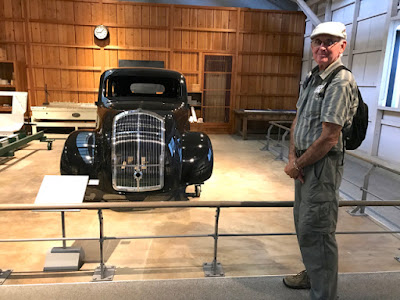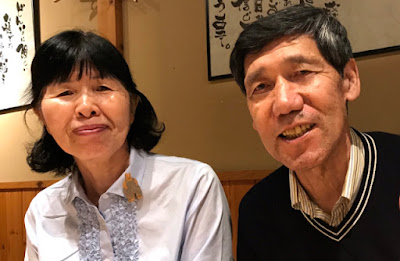 |
| Nagoya Castle |
Our day started with sunshine and a traditional Japanese breakfast, rice, fried salmon, pickled vegetables, salad, fresh fruits, green tea, rice, soup.
 |
| Itadakimasu |
We ate a leisurely breakfast, then readied ourselves for the day. Our goal today is to go to three key places in Nagoya: The Toyota Museum, the Noritake china center, and Nagoya Castle.
Our hosts acquired a bus pass for all of us on a hop-on and off type of a bus that had preferred tourist route to the three destinations we wanted to go to. It was crowded on the bus, so we were glad in each instance, we only had one stop to travel between hopping on and hopping off.
The Toyota Commemorative of Commenmorative Museum of Industry and Technology
Our first car was a Volkswagen Bus in 1969. Our second car was a Toyota Corolla in 1973, a Toyota Land Cruiser in 1984, and a Toyota Camry, in 1999. We have loved everyone of our Toyotas,
so it was with great interest that we came here today. We were surprised to learn that long before the Toyoda family started manufacturing cars, their first mechanical genius and expertise had already begun in the early 1900's in the textile industry.
The history of Toyoto Industries is the story of of Sakichi Toyoda and his son Kaiichiro. Sakichi’ aspirations was to “make people happy by enriching the nation and our society”. He also had a passion for detail and perfection in the products he produced.
The father Sakichi revolutionized the textile industry with the development of fully automated spinning and weaving machinery in the early 1900’s. Because Japan at that time lacked many of the industrial resources of the US and Europe he had to create many technologies to develop and manufacture his looms. With his own steel and casting and machine shops he created the fastest and highest quality fully automated looms.
 |
| Demonstration of how cotton fibers when pulled create a string |
 |
| Early looms |
 |
| Human weavers lost their jobs when the automated looms replaced them. One person could oversee 40 looms working full time. |
 |
| Incredibly complex looms with a variety of colored threads can weave digital prints, today. |
 |
| Woven photograph on a blanket |
After several trips overseas Mr. Toyoda realized that Japan was behind the rest of the world with many manufacturing technologies. He had a vision to produce cars and trucks like those of Ford in the USA, and his son Kaiichiro convinced him to pursue this goal. Just like the textile company his father created with the many complex machines, Kaiichiro found it necessary when developing cars that Japan did not produce the heavy steel that his company would need to manufacture the vehicles, so they also became involved in creating refined materials from raw materials to make the parts and pieces they needed.
 |
| Creating the first prototype with a wooden frame and light weight metal. |
In 1936 the first “Toyoto” passenger car rolled off the production line in Nagoya.
You might wonder why the car is not a Toyoda. For the new enterprise Toyoda held a contest to develop a new logo for the company. The winning entry incorporated the letter “d” from the Japanese Katakana alphabet which resembles a stylized “T” in the English alphabet. The “T” became the symbol of the new car company.
Several other factors unique to Japanese culture also led to the adoption of the “T”. The letter in Katakana requires eight brush stokes and 8 is considered a lucky number and the new word “Toyoto” was a break from toyada which mens “fertile rice field” in Japanese, hardly a word to inspire the new car buyer.
 |
| Yesterday |
 |
| The Future ? |
The Noritaki Factory and Museum
It is always interesting how one thing leads to another.
The Morimura brothers, Ichizaemon and Toyo, had a dream to make Japan an exporting nation. Japan had recently opened to the world in 1859 and had no goods to export other than its’ antiquities.
After visiting England, Ichizaemon wanted to develop, fine "bone china" tableware in Japan. The brothers founded a trading company in 1876 and in 1881 began exporting new porcelain products. The "bone" comes from cremated cow bones. A fine bone china plate is very translucent and strong.
This “fancy wear” became very popular in the US. Today, Noritake is a world leader in high quality ceramic wear and other high tech products that incorporates ceramic materials into solar panels and computer chips.
We were not allowed to photograph inside the art center and factory, but were allowed to photograph in the museum.
The Nagoya Castle
This beautiful castle was built in the early 16th century. It was completely destroyed during the bombing of WW II and rebuilt by the city of Nagoya in 1959.
In many of the other castles we have visited, we have not gone in or seen the living quarters, only the fortress tower part of the castle. Because Nagoya castle was rebuilt and refurbished with period-type doors and paintings, the living areas are quite interesting and gives the visitor a better frame of reference of how the feudal lords lived in their castle homes.
Like many of the castle (fortress towers), today this part of the castle is a museum and has many interesting exhibits.
 |
| Add caption |
 |
| How Did They Build Those Massive Stone Walls? |
We were in the castle fairly late in the day and have noticed throughout our travels in Japan, that visitors are notified that closing time in pending when the instrumental of Auld Lang Syne plays on the loud speaker. It was the first time we were not on the grounds, but inside the building when the tune began to play. The building closes at 5:00 pm. The music started at 4:25 and I thought, okay it's an early warning, but no, everyone starts climbing down the stairs and out the doors, almost like a fire drill.
Between the closing of the castle and our dinner reservations at a restaurant closer to our homestay hosts home, we went to the Kawabe's apartment home in Kachagawa for tea and refreshments. After refreshments we walked to a nearby restaurant where several family style foods were placed in front of us to share.
We enjoyed all of them including the fish. Neither Russ nor I are fond of fish, but we tried everything and we particularly enjoyed the swordfish kabab and the roasted sting ray. Everyone had a wonderful time despite our inability to speak and understand each other's language.
































































